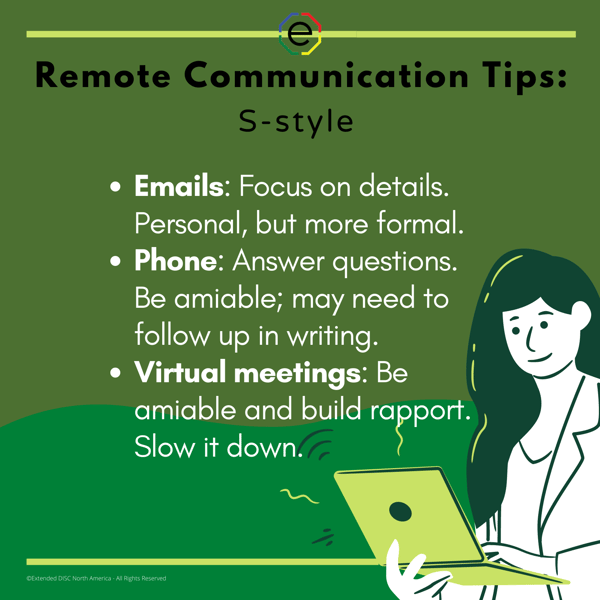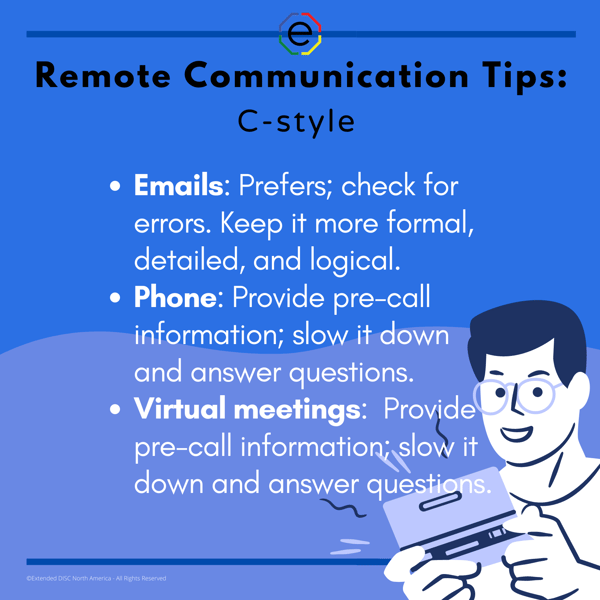Remember those frustrating emails flying back in forth with no end in sight? Why don't they understand what I am trying to say?
 We've all had experiences where we've rolled our eyes or had to let out a loud sigh because we are not communicating well. Communication, at its best, flows smoothly and both sides feel successful. Unfortunately, many interactions aren't as easy. You know what you mean, but the other person doesn't, and vice versa.
We've all had experiences where we've rolled our eyes or had to let out a loud sigh because we are not communicating well. Communication, at its best, flows smoothly and both sides feel successful. Unfortunately, many interactions aren't as easy. You know what you mean, but the other person doesn't, and vice versa.
How we communicate has more limited options right now because many of us are not able to be in our workplace setting.
Picking up the phone or hopping on a virtual meeting can feel natural for some of us. But, for others it may take more energy and sometimes anxiety. How many of you would rather send an email over a phone call? It may change how we regularly communicate, but we need to stay engaged and cohesive within our teams to work effectively.
DISC won't give you answers or hard rules to follow that will fix the problems. However, it can give you guidelines, insight, and supportive information. It serves as a reminder to keep doing what is working for you and to do it consistently.
Benefits of applying DISC
DISC styles help predict how we prefer to do things, including how we prefer to interact with others. There is no better or worse style; only different. Styles have their own preferences for how they communicate remotely. DISC reminds us we are not always on the same page.
Just as with face-to-face interactions, there are some non-verbal cues we can look for. We can better understand their preferences by understanding how they prefer to communicate with you. Do they tend to focus on tone of voice, pace of speech, the words used, focus is on details versus the broad picture, or being more task-focused vs. people-focused? Now you have more information to make better adjustments and you are more prepared.
You may be focusing on what's frustrating you about the exchange, but now you have better awareness of what may be frustrating the other person. We really need to think about that other person in the interaction too. Add to the fact, when you are feeling strong emotions like frustration, we are less likely to communicate as effectively as we'd like to.
D-styles and remote communication tips
Most of us know and own our DISC style, but we are only one side of an interaction. DISC also helps us more easily identify the style of others so we can make better decisions on how to adjust our style to improve the interaction.

D-styles want you to get to the point quickly so keep your written communication succinct and action-focused. What are you asking them to do with your information? What's the end goal and results for them? On the phone and in virtual meetings you need to be ready to go and keep it brief. D-styles act and decide fast because time is valuable. Be prepared with answers. They may become inpatient if it's taking longer or focuses too much on chit-chat.
I-styles and remote communication tips

I-styles look many and a variety of interactions. Emails may be welcome though they may prefer you just pick up the phone. If you are sending an email, don't overuse data and details because they may find it draining to go through it all. It may even get lost in their inbox. I-styles are more likely to respond if you focus on the positives, talks about them, and how it involves people .
Consider picking up the phone or setting up a quick virtual meeting. Live interactions are more likely to motivate your I-styles, especially when they have opportunities to speak and chat. While it may not be your preferred way to communicate, taking that time to engage with them is really going to make them more productive and in the end, accomplish what you needed. So, while it a phone call or virtual meeting seems to take more time, in the end it may likely save you time because the I-style is likely to respond positively.
S-styles and remote communication tips

S-styles are a reserved style so they tend to be more formal and want more details and clear instructions. However, they are a people-oriented style so they will be more personable. Even if you give them a call, they may want you to follow up in writing on how to execute the plan or mutual agreement.
They tend to respond better in smaller group or one-on-one meetings. Remember to slow it down and ask them questions directly. When you do ask questions, make sure you give them time to respond.
C-styles and remote communication tips

C-styles prefers written communication over live interactions. They want time to process the information and keeps the interaction more formal. They want to focus on the tasks. When sending emails make sure to answer their questions carefully and check your spelling and grammar. It may not be something we consider, but C-styles may respond negatively to emails that are not well thought out and correctly written.
Phones and virtual meetings are not a preference for the C-style. However, they will feel more comfortable if you prepare them ahead of time about what to expect. Remember, to slow it down and provide opportunities for them to process the information and take notes. They tend to be quieter, and may not ask questions right away. Don't forget to follow up to see if they have more questions or need more information.
Final tips and takeaways
Take a moment to consider the style of others. We can help ourselves by practicing identifying the style of others. Remember, don't jump to conclusions too quickly. Continue to refine your identification of their style as you gather more information about them.
DISC helps you make supported decisions on how to create better outcomes from your interactions. We use DISC to remind us that our communication preferences may be different and with some brief and temporary adjustments on our part, we can decrease the frustration and increase the productivity and outcomes.
Lastly, take a moment to breathe. It's the action to that pause we all need between each interaction so we can refocus and reset to create the best outcome possible.
